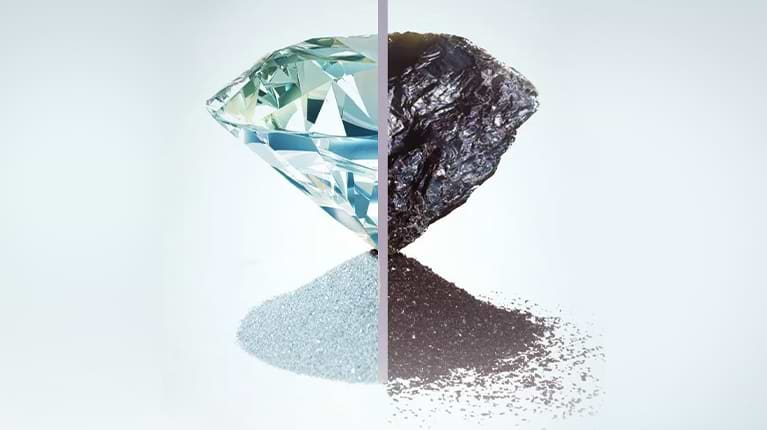Diamonds have long been considered a symbol of luxury, love, and rarity. When it comes to acquiring these precious stones, two options stand out: mined diamonds and lab-grown diamonds. Both types of diamonds share a similar appearance and chemical composition, but the process which they are created sets them apart. In this article, we will explore the key differences between mined or lab grown diamonds, offering insights into their creation, sustainability, cost, and more.
The Creation Process: Mined Diamonds vs. Lab-Grown Diamonds
Mined diamonds are formed naturally over millions of years deep within the Earth’s crust, under extreme heat and pressure. This slow process involves carbon atoms bonding together to create the crystalline structure we associate with diamonds. Mining these diamonds requires substantial effort, including the excavation of large amounts of earth to extract the gems.
Lab-grown diamonds, on the other hand, are created in controlled environments using advanced technology. The two most common methods for creating lab diamonds are High Pressure High Temperature (HPHT) and Chemical Vapor Deposition (CVD). These processes replicate the conditions under which natural diamonds form, allowing for the creation of diamonds in a matter of weeks or months rather than millions of years. Though they are created in a lab, lab-grown diamonds are identical to mined diamonds at a molecular level.
Appearance and Quality of Mined and Lab-Grown Diamonds
Both mined and lab-grown diamonds are made of carbon atoms arranged in a crystal lattice. This means they have the same hardness, brilliance, and visual appeal. The differences between mined and lab-grown diamonds are virtually indistinguishable to the naked eye. In fact, they are so similar that only specialized equipment can tell the difference.
However, lab-grown diamonds often have fewer impurities or inclusions compared to mined diamonds. This can lead to higher-quality lab-grown diamonds with better clarity. That said, both types of diamonds can be found in various grades, depending on factors like cut, color, and clarity.
Environmental Impact: Mined vs. Lab-Grown Diamonds
When it comes to sustainability, lab-grown diamonds have a significant advantage. The process of mining diamonds can be destructive to the environment. Large-scale mining operations can result in deforestation, habitat destruction, and pollution of local water sources. Additionally, the carbon footprint associated with diamond mining is relatively high due to the energy required for excavation and transportation.
In contrast, lab-grown diamonds are far more eco-friendly. While the production of lab diamonds does consume energy, the overall environmental impact is much lower compared to traditional mining. Lab-grown diamonds also do not contribute to habitat destruction, making them a more sustainable choice for environmentally-conscious consumers.
The Cost Difference: Mined vs. Lab-Grown Diamonds
One of the most significant differences between mined and lab-grown diamonds is their price. Mined diamonds are rare and come with a higher price tag due to the extensive resources required to extract them from the Earth. Additionally, the scarcity of natural diamonds increases their market value.
Lab-grown diamonds, however, are typically much more affordable. Since they are created in a lab under controlled conditions, the supply is abundant, and the production costs are lower. As a result, consumers can purchase larger or higher-quality lab-grown diamonds for a fraction of the price of mined diamonds.
Ethical Considerations: Mined Diamonds vs. Lab-Grown Diamonds
Ethics play a crucial role in the decision to choose between mined and lab-grown diamonds. The diamond industry has faced criticism over the years due to human rights violations associated with diamond mining. Mined diamonds, particularly those sourced from conflict zones, have been linked to financing violent conflicts, leading to the term “blood diamonds.”
Lab-grown diamonds, however, offer a solution to these ethical concerns. Since lab diamonds are created in a controlled environment, they are free from the exploitation often associated with diamond mining. This makes lab-grown diamonds an ethical choice for those who want to avoid contributing to unethical practices in the diamond industry.
The Market for Mined and Lab-Grown Diamonds
Both mined and lab-grown diamonds have a place in the market, with each type appealing to different consumer preferences. Mined diamonds, with their natural origins and rarity, remain a popular choice for traditionalists who value the centuries-old process of diamond formation. These diamonds are often viewed as more prestigious and are still considered the “classic” choice for engagement rings and other fine jewelry.
Lab-grown diamonds, however, are gaining traction among consumers who value affordability, sustainability, and ethical considerations. As technology continues to improve, lab-grown diamonds are becoming increasingly popular for a wide range of jewelry, from engagement rings to fashion pieces. Many jewelers now offer lab-grown diamond options, and the market is expected to grow as consumers seek alternatives to traditional mined diamonds.
Final Thoughts: Mined or Lab-Grown Diamonds?
Ultimately, the decision between mined and lab-grown diamonds depends on personal preferences and values. Mined diamonds, with their natural origin and rarity, continue to be a timeless symbol of luxury and tradition. On the other hand, lab-grown diamonds offer a more affordable, sustainable, and ethical alternative that appeals to those who prioritize environmental and social responsibility.
Whether you choose a mined or lab-grown diamond, you can rest assured that both types are stunning and durable. The beauty and allure of diamonds remain unchanged, regardless of their origin. The key is to choose the option that aligns best with your beliefs, budget, and style.






